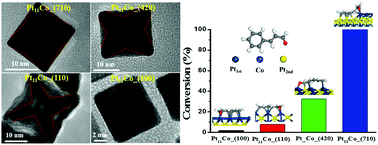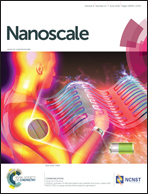Bimetallic PtxCoy nanoparticles with curved faces for highly efficient hydrogenation of cinnamaldehyde†
Abstract
The control of the curved structure of bimetallic nanocrystals is a challenge, due to the rate differential for atom deposition and surface diffusion of alien atomic species on specific crystallographic planes of seeds. Herein, we report how to tune the degree of concavity of bimetallic PtxCoy concave nanoparticles using carboxylic acids as surfactants with an oleylamine system, leading to the specific crystallographic planes being exposed. The terminal carboxylic acids with a bridge ring or a benzene ring serving as structure regulators could direct the formation of curved faces with exposed high-index facets, and long-chain saturated fatty acids favored the production of curved faces with exposed low-index facets, while long-chain olefin acids alone benefited the formation of a flat surface with exposed low-index planes. Furthermore, these PtxCoy particles with curved faces displayed superior catalytic behaviour to cinnamaldehyde hydrogenation when compared with PtxCoy with flat faces. PtxCoy nanoparticles with curved faces exhibited over 6-fold increase in catalytic activity compared to PtxNiy nanoparticles with curved faces, and near 40-fold activity increase was observed in comparison with PtxFey nanoparticles with curved faces.


 Please wait while we load your content...
Please wait while we load your content...